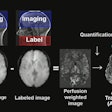SINGAPORE -- A quantitative MRI technique called 3D amide proton transfer imaging (3D-APT) can help in distinguishing between triple-negative and non-triple-negative breast cancer, according to research presented May 6 at the International Society for Magnetic Resonance in Medicine (ISMRM) 2024 meeting.
Saiqun Lyu from the Affiliated Hospital of Chengdu University in China said that 3D-APT demonstrated higher transfer values in triple-negative breast cancer patients. Additionally, 3D-APT’s value was further augmented by the addition of diffusion-weighted imaging (DWI).
“These findings hold significant value as a crucial point of reference for developing individualized treatment strategies and assessing prognosis in clinical practice,” Lyu and colleagues highlighted.
Triple-negative breast cancer is highly aggressive, prone to recurrence, and tied to a poorer prognosis than other breast cancer types. This means that accurate identification of these cancers is important for treatment decisions and prognosis assessment.
Advanced imaging techniques have been explored in this area, including 3D-APT and DWI. 3D-APT is a quantitative imaging technique that can noninvasively detect amide protons in endogenous low-concentration proteins and peptides. This reflects their concentration and environmental changes.
However, Lyu said there are still aspects of molecular subtyping from these imaging techniques that have not yet been explored.
Lyu and colleagues studied the potential application value of both 3D-APT and the combination of 3D-APT with DWI in distinguishing between triple-negative breast cancer and non-triple-negative breast cancer. The study included data from 53 confirmed breast cancer cases collected in 2022 and 2023, of which 18 were triple-negative breast cancer and 35 were not.
All MRI scans were performed on a 3.0T MRI scanner (Signa Premier, GE HealthCare). These included conventional MRI, dynamic contrast-enhanced imaging, 3D-APT, and DWI.
The team reported that APT and apparent diffusion coefficient (ADC) values were significantly higher in patients with triple-negative breast cancer.
| Comparison between patients with, without triple-negative breast cancer | |||
|---|---|---|---|
| Non-triple-negative | Triple-negative | p-value | |
| Amide proton transfer | 1.97% | 2.43% | < 0.05 |
| Apparent diffusion coefficient | 0.97×10-3mm2/sec | 1.20×10-3mm2/sec | < 0.05 |
The researchers also reported that the area under the receiver operating curve (AUC) values for APT and ADC in distinguishing between triple-negative and non-triple-negative breast cancer were 0.82 and 0.85, respectively (p = 0.96).
However, when APT was combined with ADC, the AUC increased to 0.91, a statistically significant change (p < 0.05).
Lyu said these findings hold significant importance in allowing for early diagnosis and guiding treatment decisions for triple-negative breast cancer. He added that this technique yields valuable insights for clinical practice.

